The 26 Types of Influencers You Need to Know for Your Brand [With Examples]

Influencer marketing has exploded — more than 50 million people around the globe consider themselves “influencers.”
How to choose the right social media influencer for your brand in such a crowded space? By understanding the various types of influencers and narrowing down exactly what you need.
In this article, the different types of influencers are divided into:
- Follower count
- Content
- Occupation/Relationship
Let’s dive in! 👇
4 Different Types of Influencers Based on Follower Count
Love it or hate it, influencer marketing is still a numbers game, no matter what types of social media platforms you look at. All types of influencers are paid in part for their number of followers (and sometimes, engagement rates) — meaning their total followers directly affects their influencer rates.
But a large followers number doesn’t necessarily translate to a wider influence — the number of followers isn’t correlated to influencer marketing ROI. It’s a fool’s strategy to spend all your influencer marketing budget on accounts boasting a large following.
Read ahead to understand the different levels of influencers and how they can be divided into four categories based on the number of followers and the pros and cons of working with each.
#1: Micro-influencers
Number of followers: 5,000 — 100,000
We define micro influencers by the number of followers. The average micro-influencer isn’t a household name. These aren’t social media influencers and don’t have millions of followers. They’re your regular Joes with a tightly-knit community sharing their love and passion for a particular niche. Be wary of micro-influencers who might be fake influencers (AKA they buy followers and engagement) to get company sponsorships.
Example of a micro-influencer: Elyse Miller
Elyse Miller is a mid-tier fitness influencer who shares content around workouts, staying healthy, and shifting to a positive mindset on her instagram account. Look at how she partners with drinkware brand, HydroJug, to share influencer posts around how their products keep her hydrated during strenuous workout sessions.
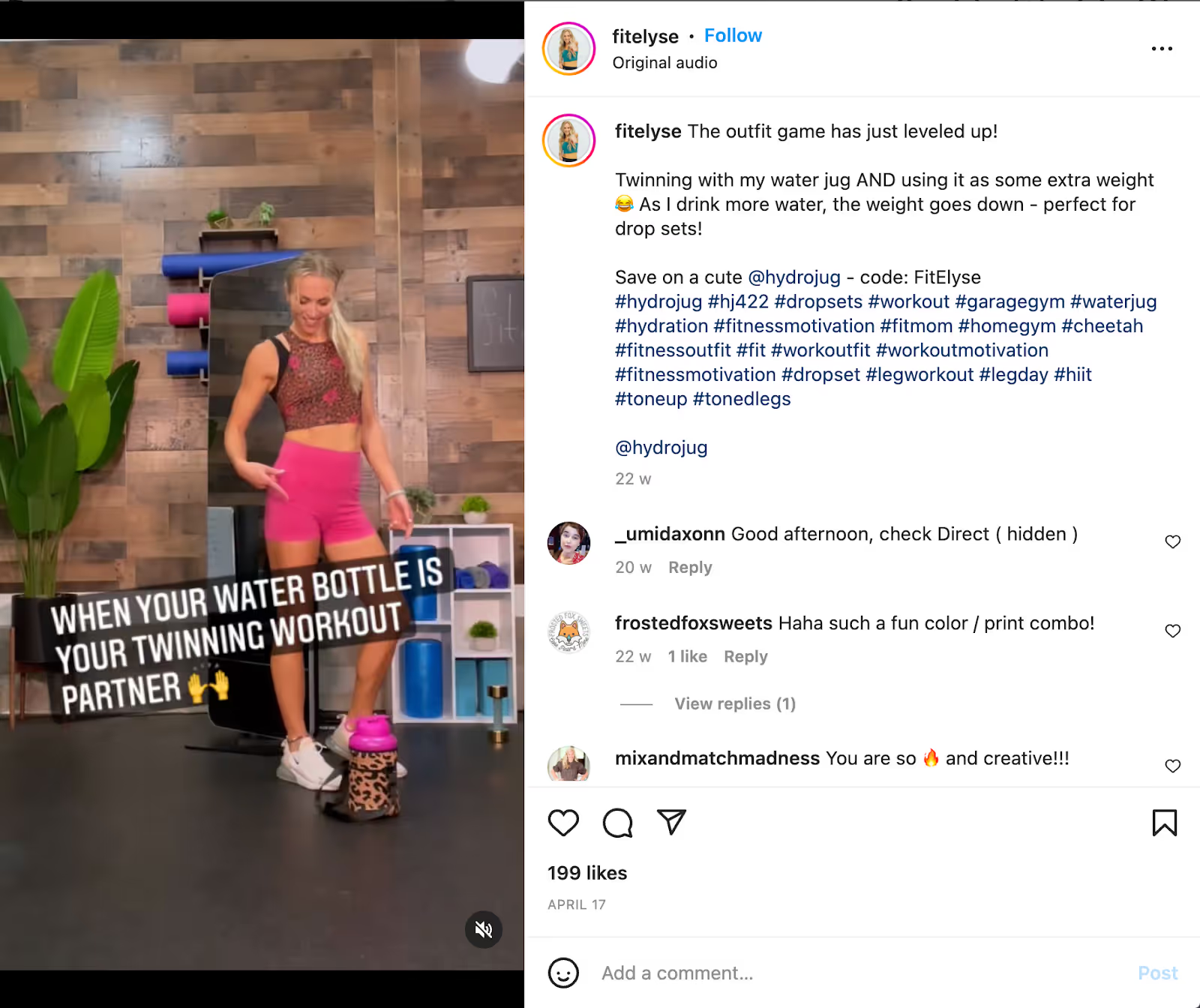
Pros of working with a micro-influencer:
- They are more relatable — translating to them having a deeper connection with their audience
- They have a high engagement rate — even higher than other types of influencers
- They are more cost-effective to partner with than larger creators
Cons of working with micro-influencers:
- Tracking the performance of 10 micro-influencers is more work for you than partnering with just one macro-influencer
- Finding niche micro-influencers with an engaged following who aren’t fake influencers takes considerable research
- Micro-influencers have fewer followers — offering limited reach and brand awareness
Micro-influencers are the right influencers for you if:
- You have specific marketing campaigns — like boosting product reviews of your latest product
- Your priority is collaborating with niche social media influencers over reaching a wider following
- You have a shoe-string influencer marketing budget
Read more: Guide to Micro-Influencer Marketing
#2: Mid-tier influencers
Number of followers: 100,000 — 500,000
Mid-tier influencers have more than 100K followers and are the sweet spot between macro and micro-influencers. They aren’t brand new as micro-influencers, so they have polished content ability and experience working with brands. But they still don’t have a humongous following like macro-influencers — meaning their content retains its authenticity, and their audience is still niche.
Example of a mid-tier influencer: Noel Arevalo
Noel Arevalo is a mid-tier fitness influencer and a fitness coach. She creates content about working out, making healthy smoothies, and wearing the right workout clothes. Here’s an example of her sharing how she takes 1st Phorm’s collagen to improve her hair health.

Pros of working with mid-tier influencers:
- Mid-tier influencers have just the right amount of reach with their 100K+ followers — not as niche and limited as micro-influencers, but not as wide and varied as macro-influencers
- Mid-tier influencers are easy to work with because they have experience working with brands to reach their desired instagram users
- Mid-tier influencers command moderate prices
Cons of working with mid-tier influencers:
- Mid-tier influencers don’t have the same level of niche orientation as micro-influencers
- Mid-tier influencers don’t have as high an engagement rate as smaller influencers
- Mid-tier influencers demand higher pay because of their high follower-count
Mid-tier influencers are the right influencers for you if:
- Your influencer marketing strategy is to go wide rather than deep
- You want a middle ground in costs and benefits from influencer marketing
- You want to work with an experienced influencer, but can’t afford macro-influencers
#3: Macro-influencers
Number of followers: 500,000 — 1M
Macro-influencers are social media stars — they have earned their fame online and are now capitalizing on their high engagement. They have a large following from a broader demographic. Macro-influencers are the types of influencers who are considered experts in the influencer marketing game.
Example of macro-influencer: Nona Bayat
Nona Bayat is a Gymshark athlete and macro-influencer posting about workouts and nutrition. She regularly shares her discount code with her followers for the vegan supplements brand, One Sol.
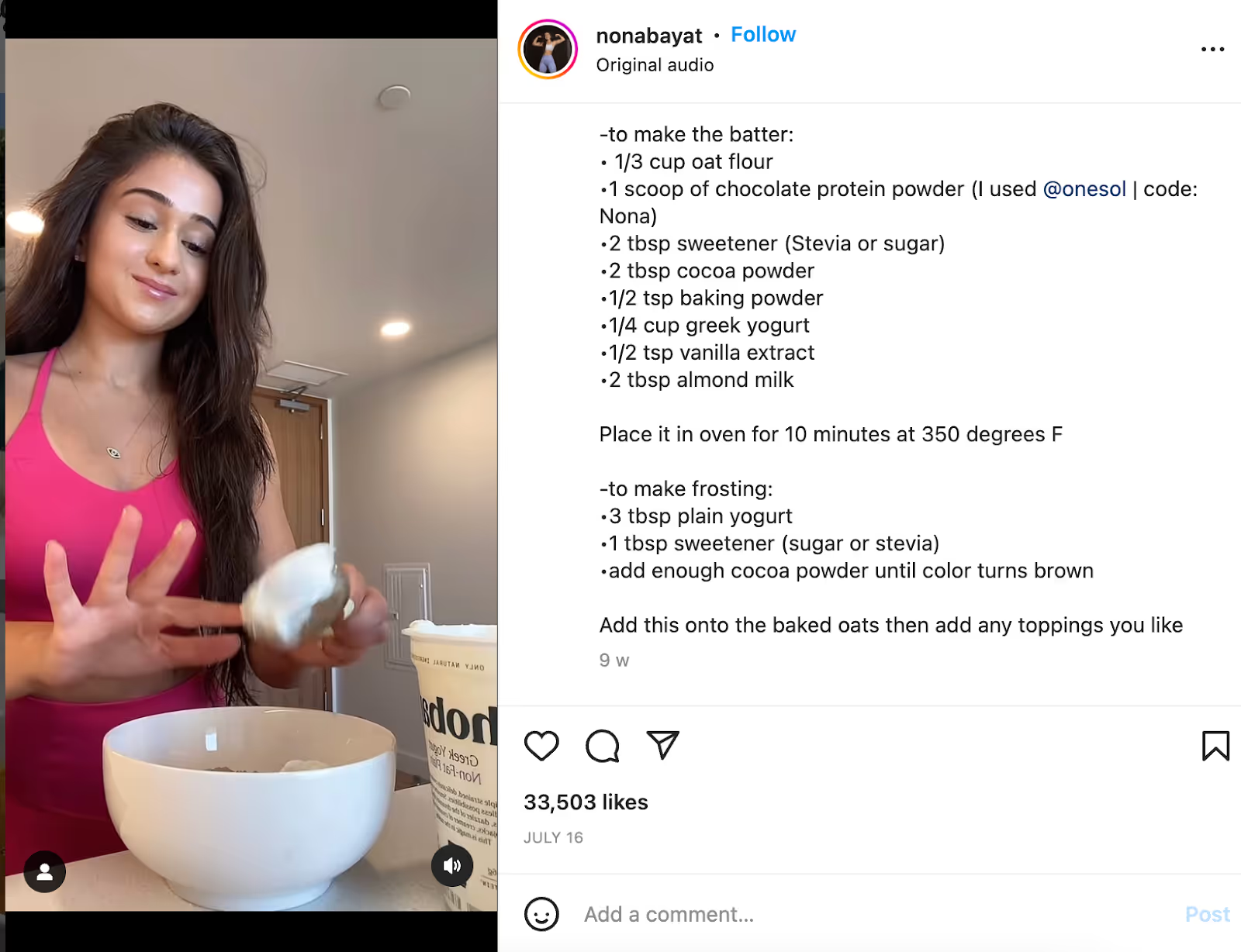
Pros of working with macro-influencers:
- They have a large number of followers, providing you with a broad reach
- Macro-influencers have excellent content creation abilities and professionalism because they’ve been in the game for a while
- Partnership with macro-influencers offers brand exclusivity since they have the internet’s celebrity status — they’re essentially your edge against competitors
Cons of working with macro-influencers:
- Macro-influencers can be inaccessible because they work with talent managers and are swarmed with brand partnership requests
- Macro-influencers have less trust among their followers because of low relatability and a staged product appearance
- Macro-influencers charge extremely high rates because of the size of their audience
Macro-influencers are the right influencers for you if:
- You want to tap into a new and large audience
- You want professional-looking influencer content
- You want to partner with a well-known internet star
#4: Mega-influencers
Number of followers: 1M+
Mega-influencers are public figures with a large following on social media. These top social media influencers are often celebrities and trendsetters with a loyal fanbase with at least a million followers. Then it’s no wonder they can create a demand for a product or service. Partnering with these types of instagram influencers can rocket-fire your brand visibility.
Example of a mega-influencer: Jen Selter
Jen Selter is one of the celebrities in the fitness niche with more than 13 million followers. Her posts center around nutritional recipes, workouts, and lifestyle content. An example is her partnership with BlendJet — she frequently recommends them as her go-to blender of choice to make delicious and healthy smoothies. f
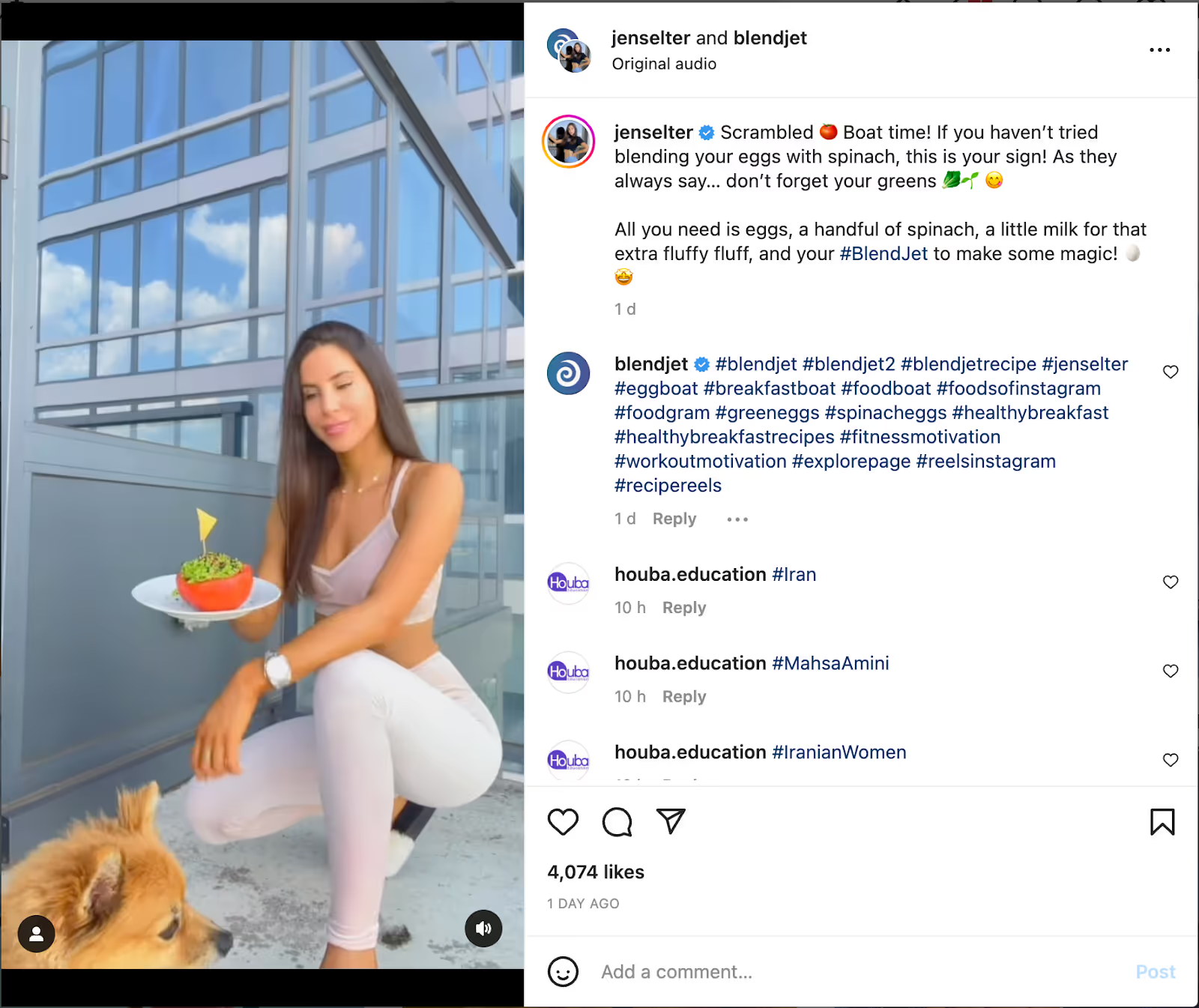
Pros of working with mega-influencers:
- Mega-influencers have a large team of people managing their social media — meaning your brand will get high-quality content
- Mega-influencers are celebrities — so they have the potential to reach a lot of people and can provide a significant impact through their large audience
- Being endorsed by the right mega-influencer gives your brand a certain edge and exclusivity
Cons of working with mega-influencers:
- Mega-influencers have a high price tag. You need a larger-than-life budget to hire even one mega-influencer
- Due to their large following, mega-influencer celebrities can’t cultivate a personal connection with their followers — they don’t have high engagement rates
- Mega-influencers have a diverse audience of all demographics — making it difficult for you to target a specific customer segment for your influencer marketing campaign
Mega-influencers are the right influencers for you if:
- You have a pretty humongous penny set aside for your influencer marketing efforts
- You’ve been in the influencer marketing game a while and want to make a big splash for brand awareness
- You want to associate your brand with the cool kid and tap into the potential of their millions of followers
13 Different Types of Social Media Influencers Based on Content
Social media influencers can also be categorized based on their specific niche, AKA, the type of content they create. The most common 13 different types of influencers based on their specialization are listed below:
#1: Fashion Influencers
Fashion influencers garner engagement by showing people how to dress and influenceing their wardrobe. Influencers show the products they purchase from brands, post reviews about the clothes they like, and often become trendsetters with their fashion choices and personal style.
Example of a fashion influencer: Sonakshi
Sonakshi is a fashion influencer creating minimalist outfit inspirations. She partnered with clothing company, Roots, to introduce their Journey collection in spring. She partners with similar fashion brands and reviews their products — along with showing how to style them.
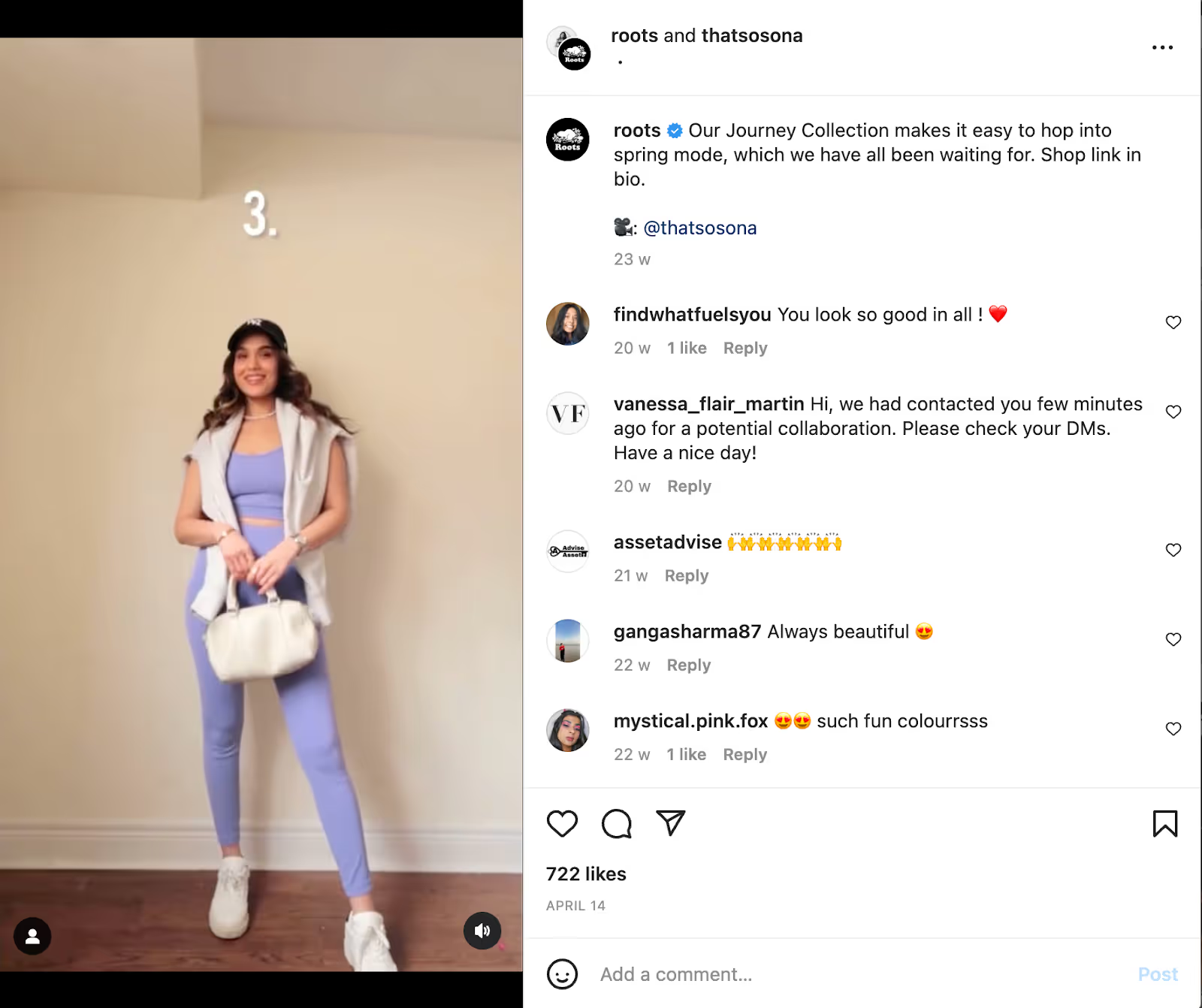
#2: Health & Wellness Influencers
Health & wellness influencers are creators sharing their subject matter experts regarding nutrition, medicines, mental health, or overall well-being. These types of influencers’ audience trusts them to provide reliable product recommendations to keep themselves healthy and fit.
Example of a health and wellness influencer: Amanda Rocchio
As a health influencer, Amanda Rocchio shares food tips and how to cook healthy recipes. Her partnership with SmartSweets to run a giveaway on Instagram is a great example of different types of brand collaborations you can do with experts in your industry.
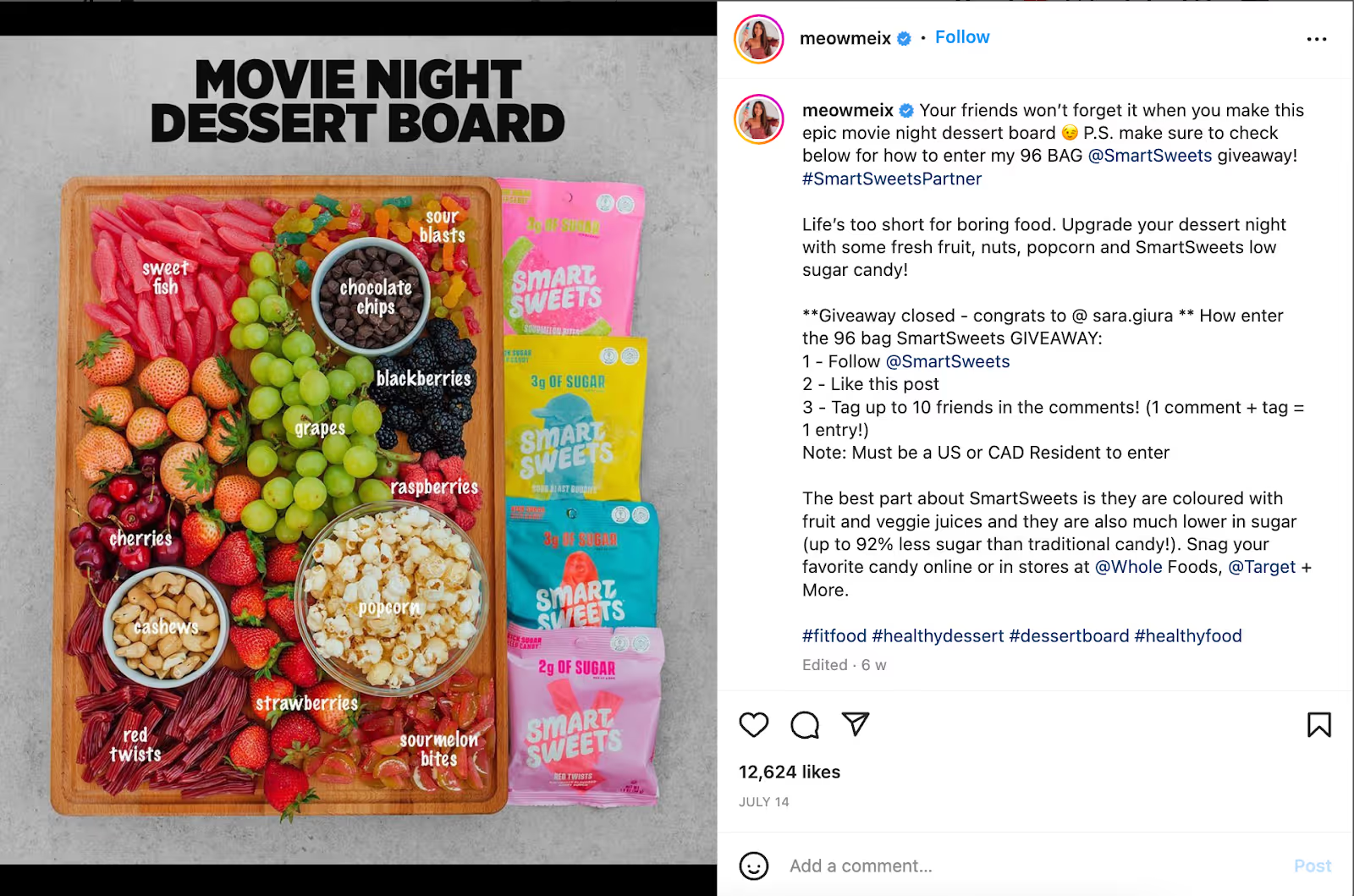
Read more: The Ultimate Influencer Marketing Guide for Health & Wellness Brands in 2024
#3: Beauty Influencers
Beauty influencers are the types of influencers who share content around all things beauty, make-up, haircare, and skincare. They often review cosmetic products and have an impact on what their followers purchase. While it might seem like beauty influencers are limited to the female gender, there’s no such restriction. Male beauty products often hire influencers to promote their products and drive sales.
Example of a beauty influencer: Manny Gutierrez
Manny Gutierrez posts makeup content, product reviews, and most of all — breathtaking eye looks. He partners with many brands, but his most creative collaboration is with the cosmetic company, Laneige, as their brand partner.
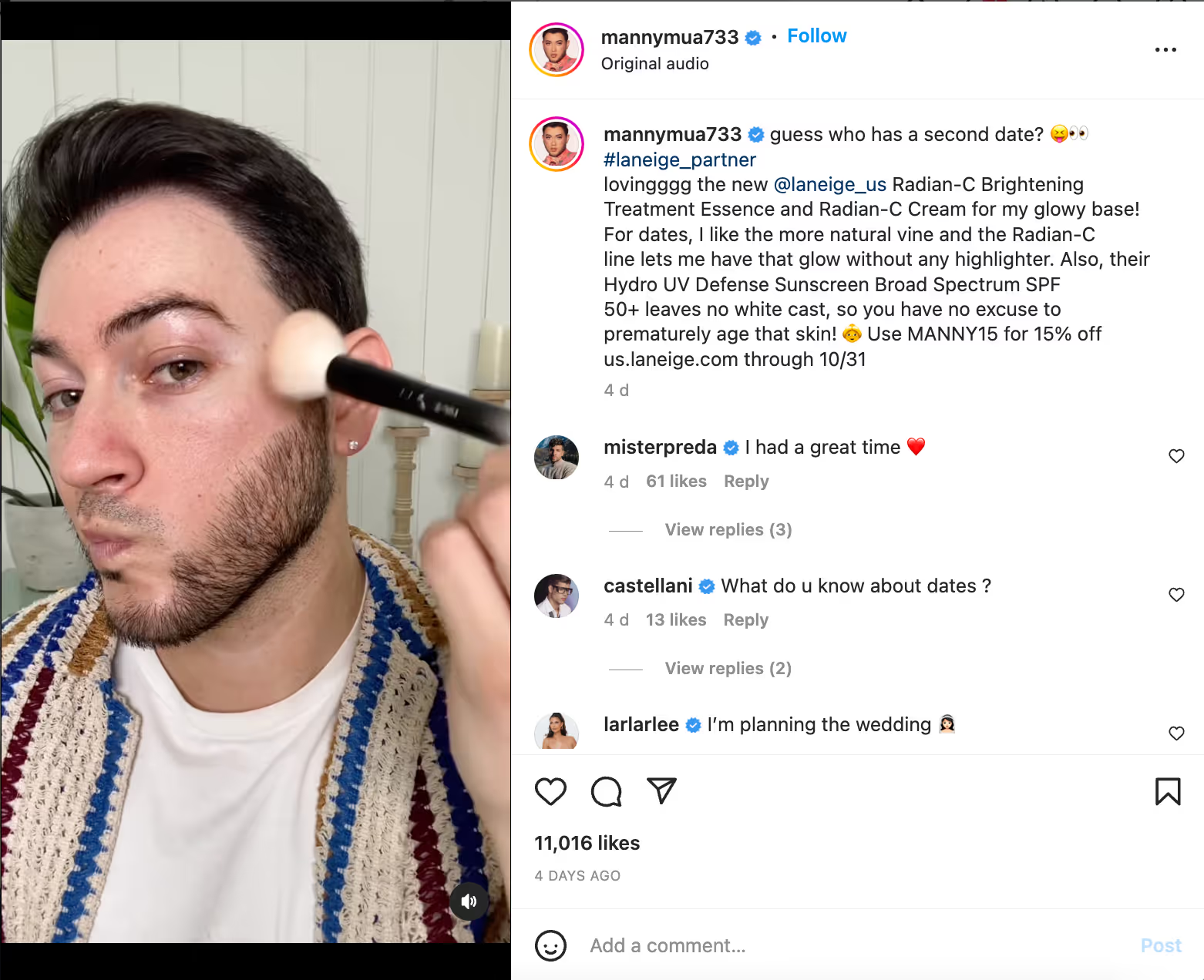
Read more: Influencer marketing for beauty brands
#4: Lifestyle Influencers
Lifestyle influencers post varying content around their personal routine, fashion choices, and their life in general. These types of influencers aren’t subject matter experts, but their audience follows them for aspiration or likeability — which often translates to high engagement.
Example of a lifestyle influencer: Natalie Kennedy
Natalie Kennedy is a lifestyle blogger from Nashville posting about outfits, skincare product recommendations, and her family. She often shares unique links for a special discount code with her audience. For instance, she partnered with the clothing company, Dress Up, and shared a discount code with her Instagram followers.
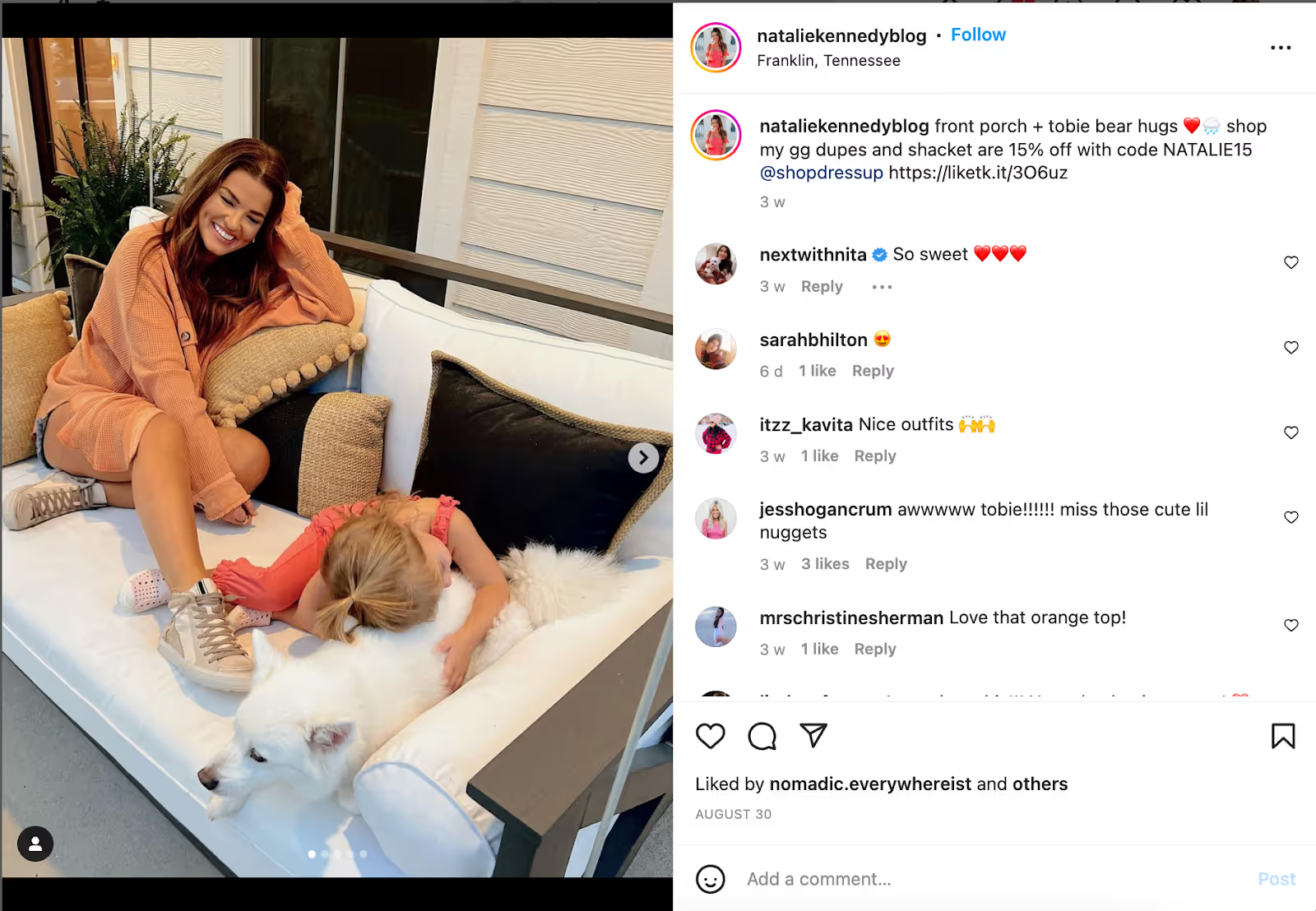
#5: Food Influencers
Food influencers influence the way people eat. These types of influencers can be dieticians sharing how to lose weight or local restaurant reviewers rating the new cafe. These creators can drive how people feel about a particular food and sway customers’ opinions.
Example of a food influencer: Michelle Tam
Michelle Tam is an NYT bestselling author and a thought leader in the food space sharing healthy recipes with her audience. She partnered with cookware company, Anyday, to conduct a giveaway on Instagram on her birthday.
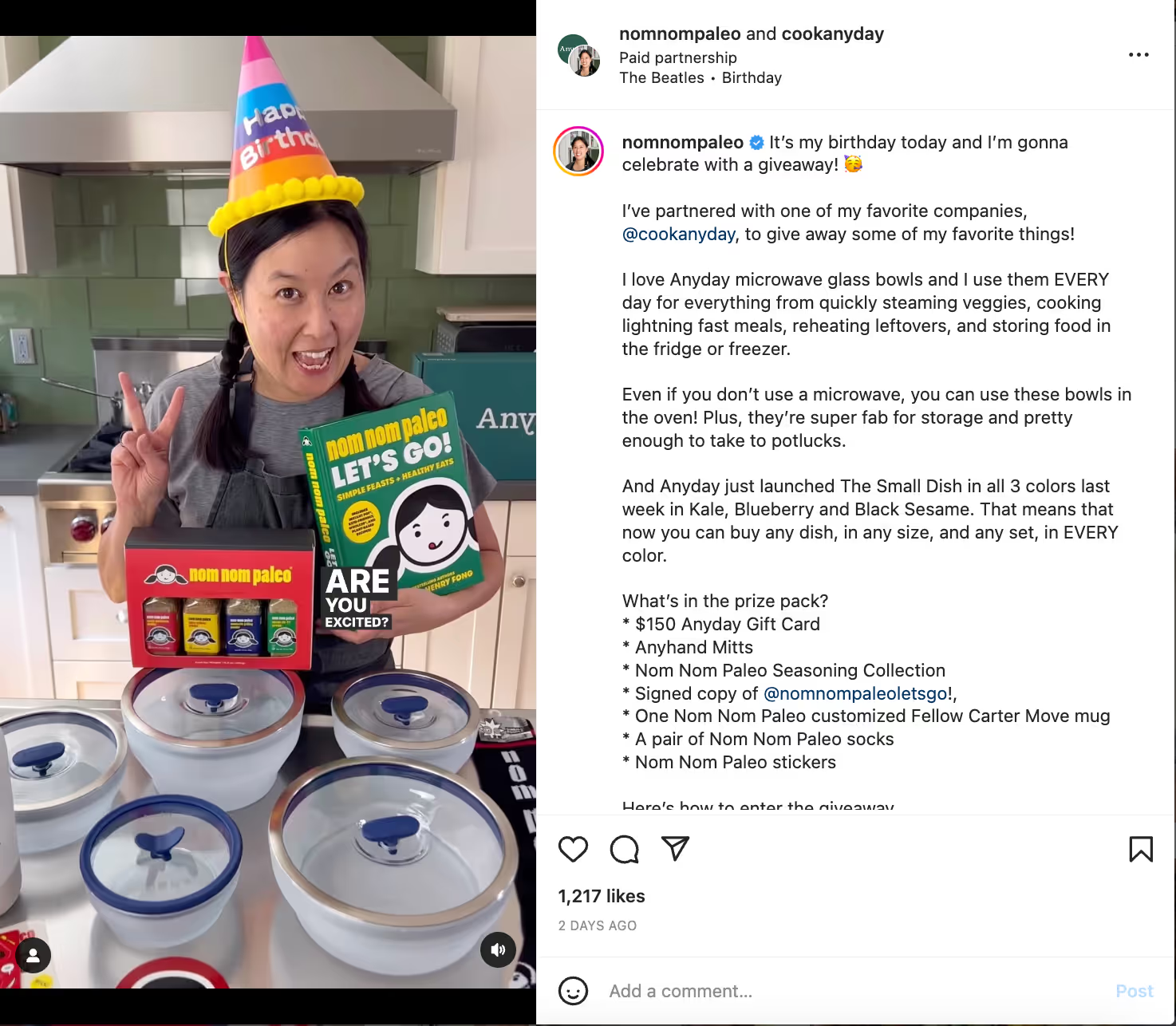
#6: Pet Influencers
The influence of social media influencers has extended to animals. Pet influencers talk about how to take care of your pets and which products to buy them — all while sharing cute paw pictures. And these influencers can help all sorts of pet companies. They aren't limited to cats and dogs — they're in the realm of owning horses, hamsters, birds, and more.
Example of a pet influencer: The Wanderlust Dogs
The Wanderlust Dogs is a Seattle-based team of three adorable dogs — Samantha, Elvis, and Magnolia. Their Instagram feed is filled with the adventures they go to and the products they carry along with them. For instance, they partnered with Only Natural Pet to share a story about how they get stains and odors removed using their products.
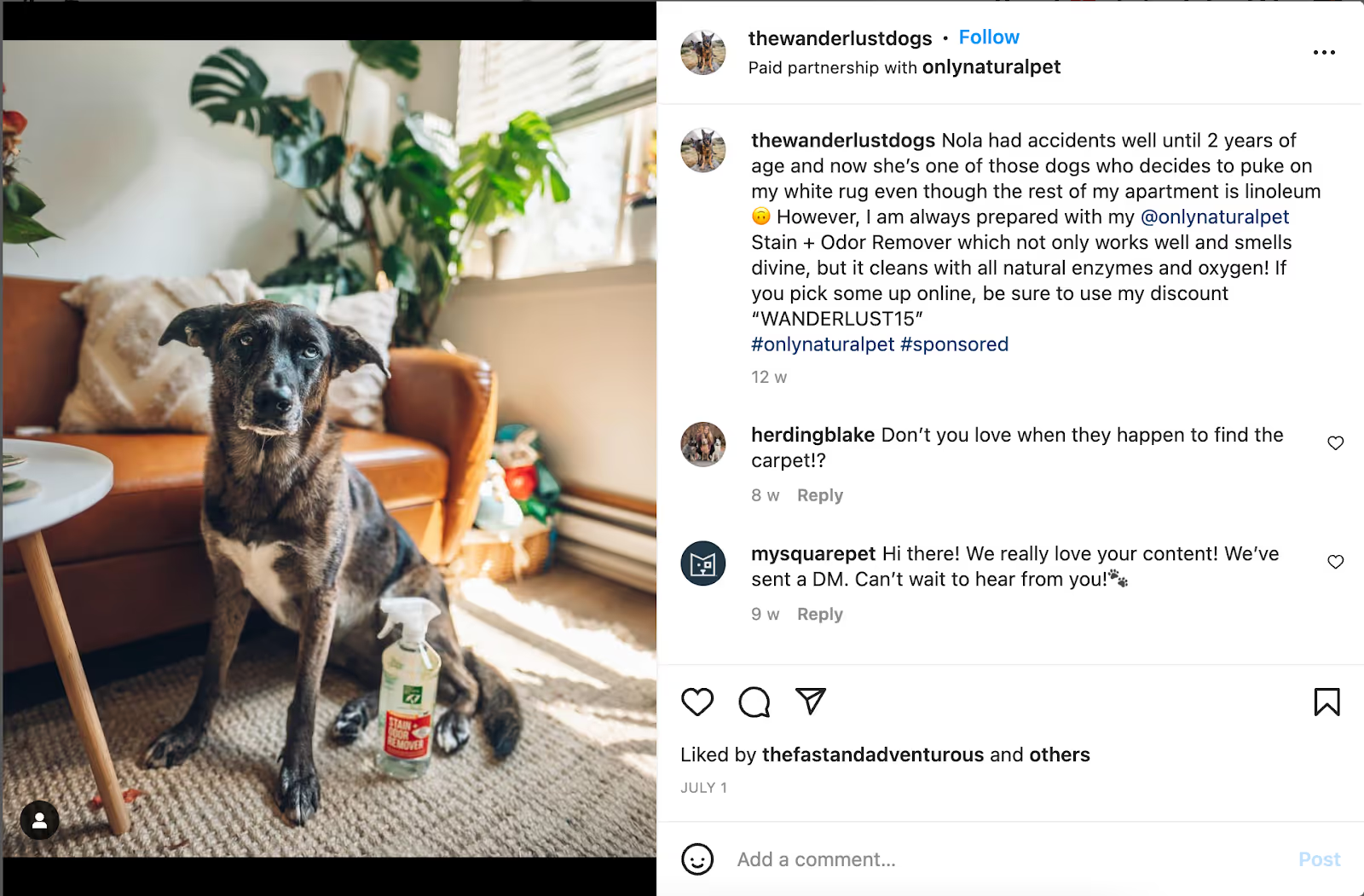
#7: Sports & Fitness Influencers
Sports and fitness influencers can cover varying niches like yoga, gymming, home workouts, pilates, nutrition, weight loss, healthy lifestyle, and more. These types of influencers usually walk the talk on how to remain fit and endorse products in the same industry.
Example of a sports and fitness influencer: PersianStorm
PersianStorm is a sport psychologist and fitness trainer sharing workouts and motivating captions. She partnered with Apollo Neuro and talked about how their product helps her stay consistent, regulate her nervous system, and balance her HRV.
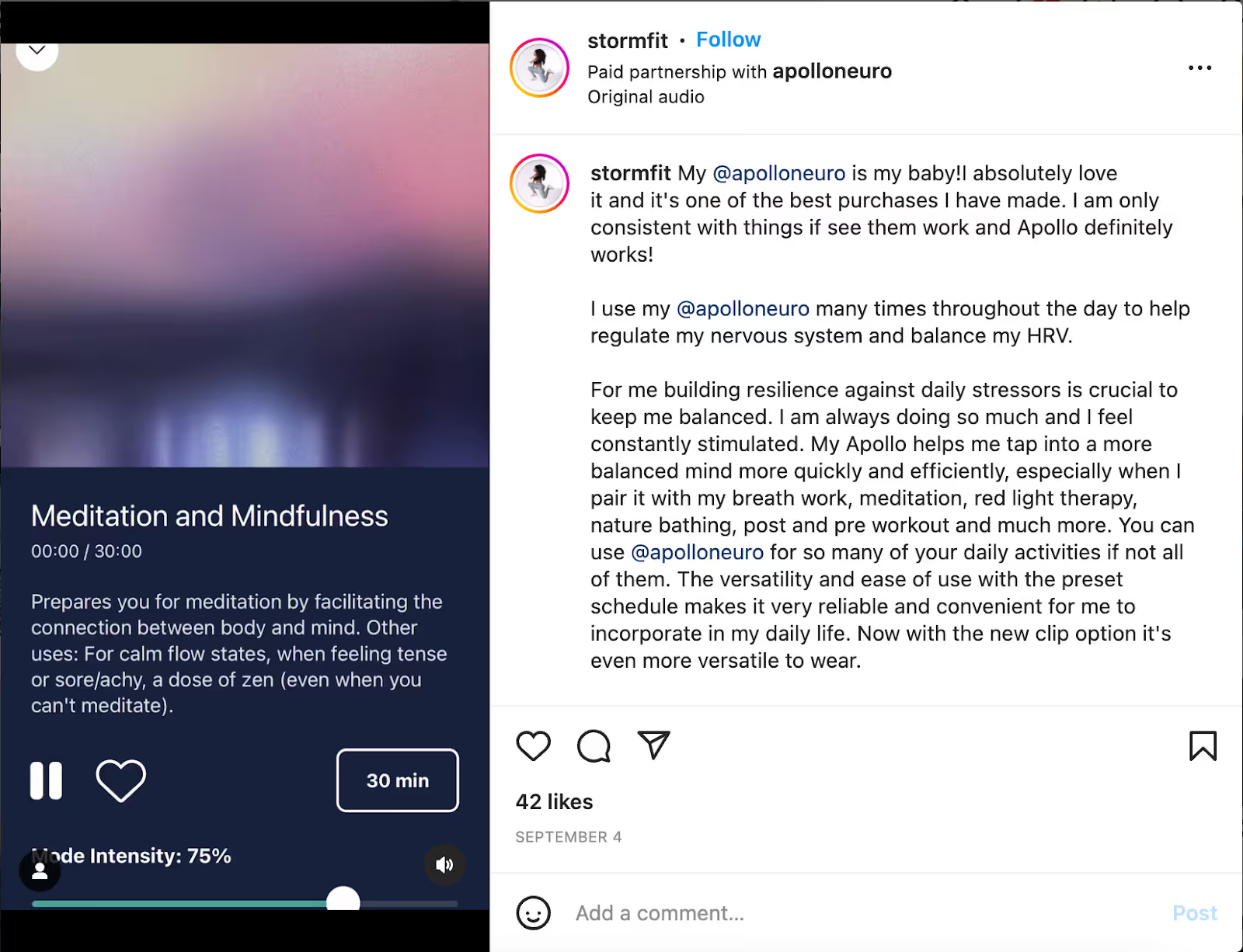
#8: Travel Influencers
Travel influencers share tips regarding all things travel — places to visit, travel-related products, and hotels to stay in. These types of influencers inspire their audience to pursue their travel goals and recommend a pathway to reach there.
Example of travel influencer: Amanda Bloomquist
Amanda Bloomis a travel enthusiast who loves hiking, camping, and staying outdoors. No matter where she’s traveling to next, she keeps her Instagram followers updated — and shares unique discount codes for useful travel products, as she did for her affiliate partnership with Stio.
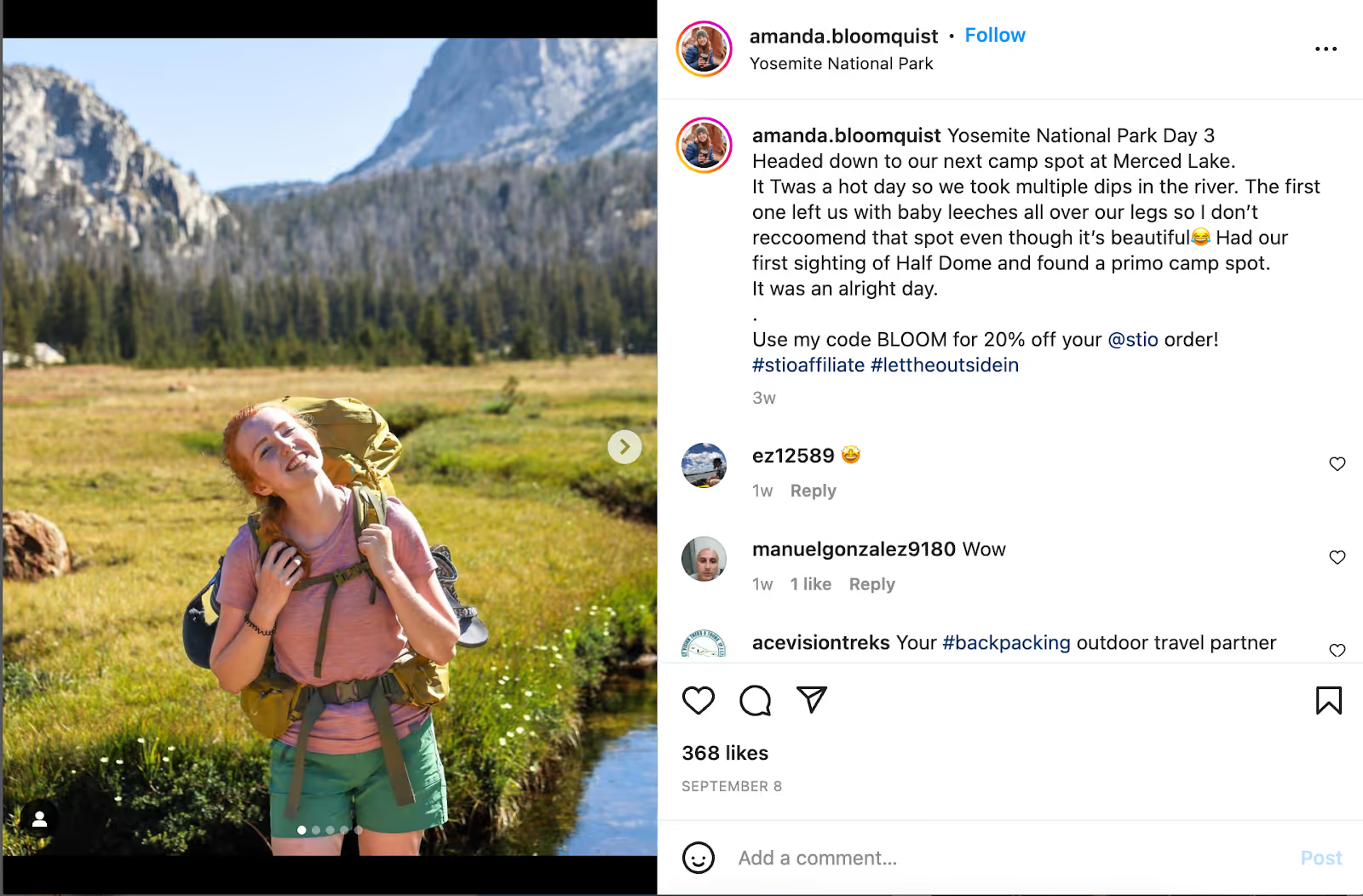
#9: Parenting Influencers
Parenting influencers are the OG mom and dad (or mom and mom or dad and dad) telling other parents how to do it right. These influencers usually share product recommendations for new parents, tips on how to parent, and their own parenting stories.
Example of a parenting influencer: Jordan And Robin
Jordan and Robin are a California-based mom-life duo on Instagram. They share products their kids love, help them relieve stress, and are helpful to the parenting community. For instance, they posted a ‘mom hack’ on Instagram about using the Huckleberry Care mobile app to track their baby’s nap times, feeding, sleep, and more.
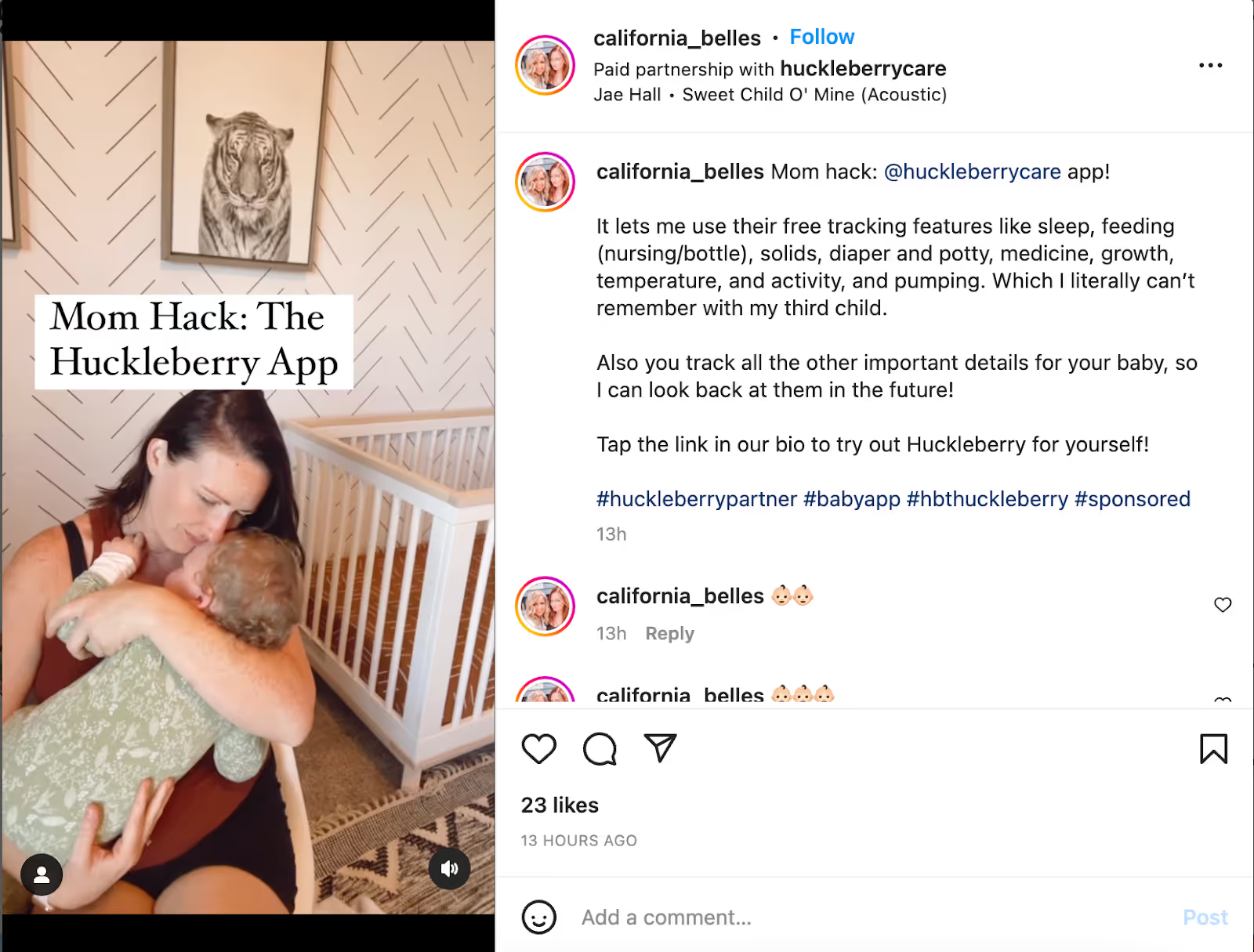
#10: Gaming Influencers
Gaming influencers often live stream their games on Twitch or YouTube, garnering millions of fans looking to learn more about gaming. These types of influencers also talk about other gaming content, tutorials on a game, walkthroughs, and montages.
Example of a gaming influencer: Ali Hassan
Ali Hassan is a mega-influencer in the gaming community, better known as SypherPK. He shares content around all things Fortnite and is also a streamer on YouTube and Twitch. He partners with big-name brands like Samsung to promote their products and how they can be helpful while gaming.
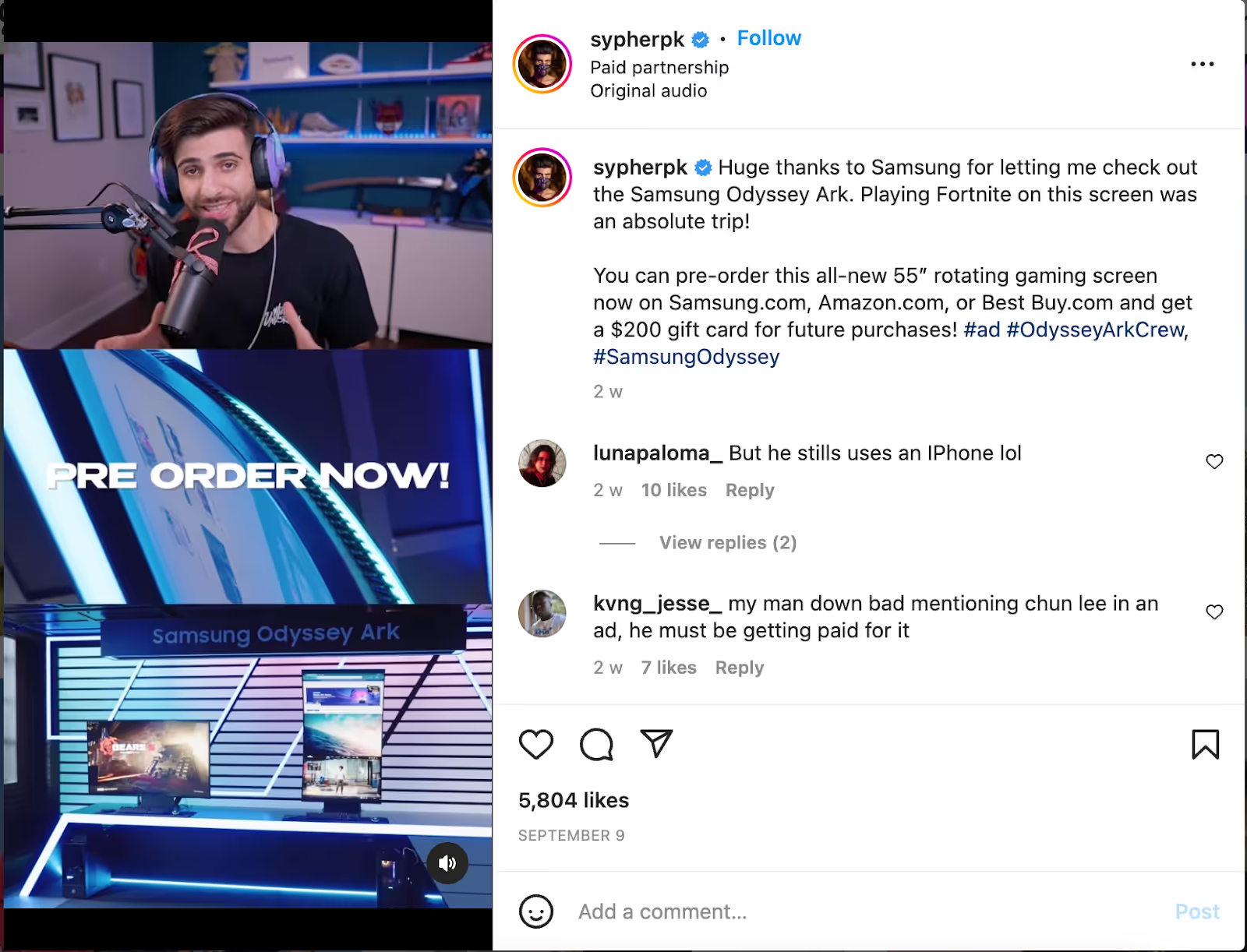
#11: Technology Influencers
Technology influencers are social media influencers who review the latest tech products and services — like mobiles, laptops, iPads, and more. Their audience values their opinion — impacting their purchase decisions.
Example of a technology influencer: TechMeOut
TechMeOut covers everything tech — from product reviews of iPhones to unboxing home tech products. A good example is the collaboration between TechMeOut and Ecobee Home on Instagram, sharing details about their thermostat.
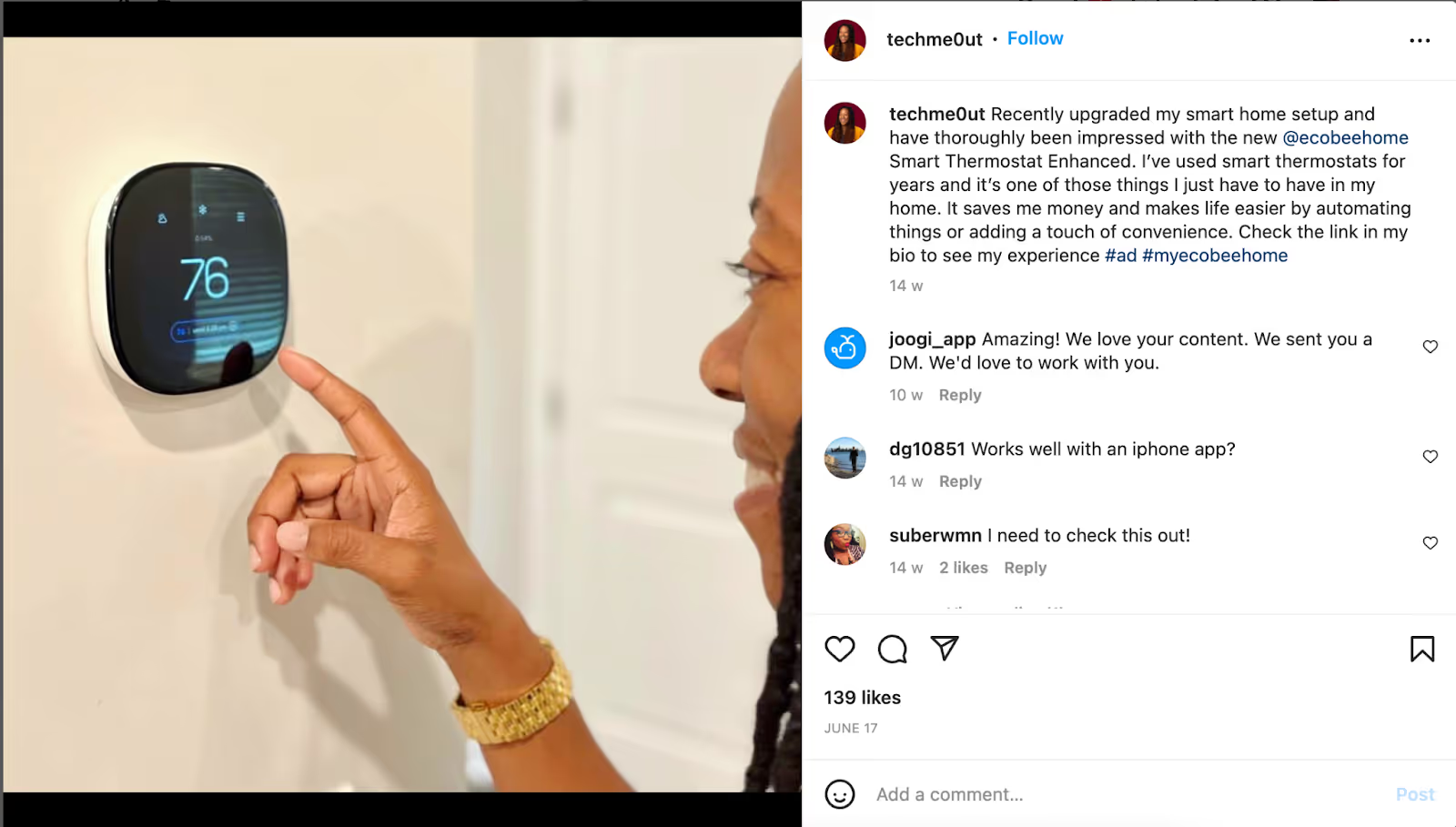
#12: Entertainment Influencers
It’s self-explanatory what entertainment influencers do: They entertain. These types of influencers can be comedians or overlap with lifestyle influencers — helping brands reach a wider audience through their content.
Example of an entertainment influencer: Joe Ando
Joe Ando is an entertainment influencer, often sharing comedy videos and pictures of him and hopping on trends with his unique spin. He partnered with TOMS and KROST to promote their new line of products.
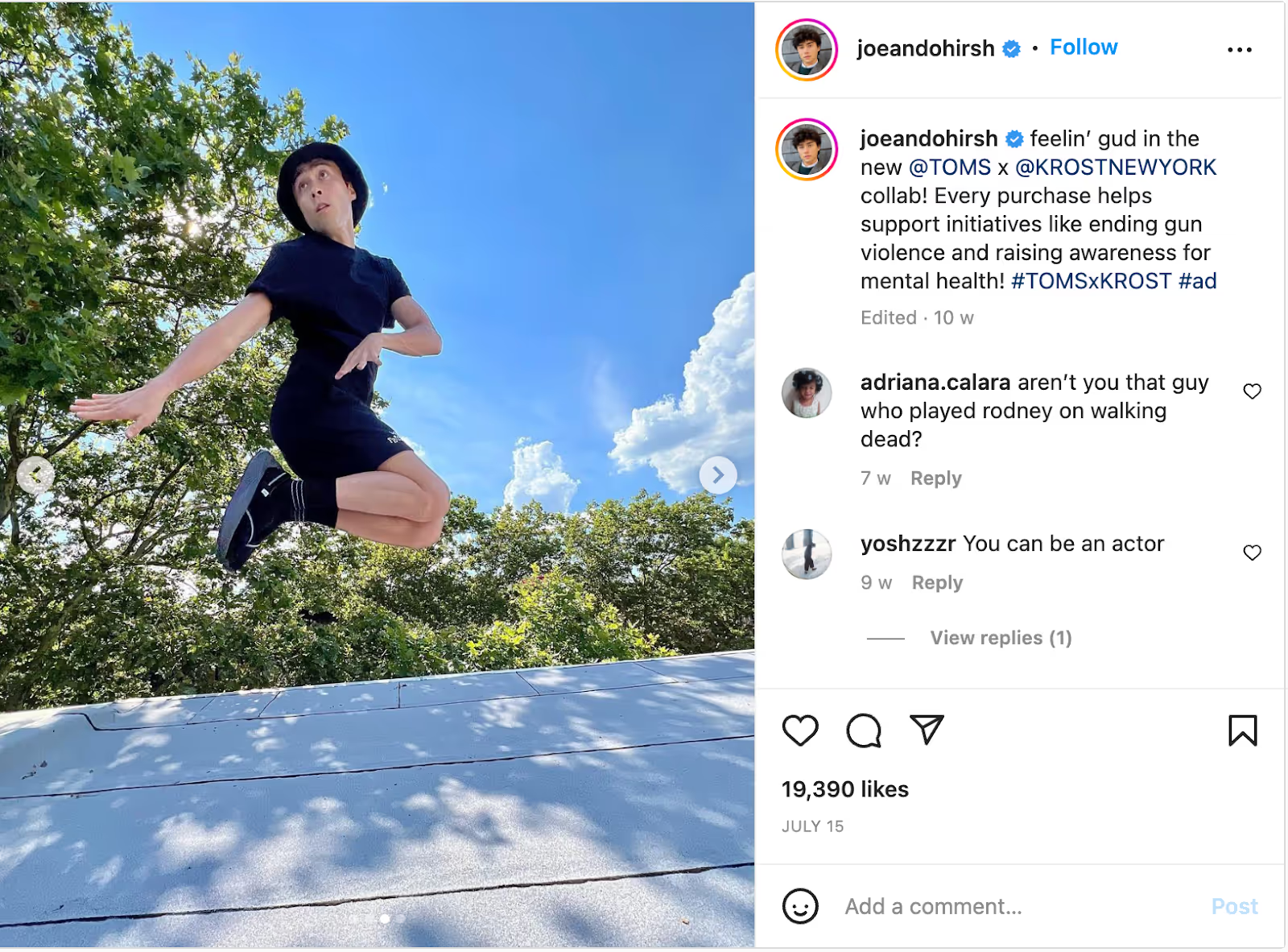
#13: B2B Influencers
B2B influencers influence decision makers in large organizations — whether or not they’re the ones who take out the wallet is irrelevant. They’re thought leaders in their space and can significantly impact a targeted audience.
Example of a B2B influencer: Aaron Orendorff
Aaron Orendorff is a thought leader in the marketing industry. Klaviyo sent him cookies for their Less Stalking, More Talking campaign — which led to him sharing a Twitter post about the company and garnering a ton of engagement.

Read more: Does B2B Influencer Marketing Work? Expert Advice for Brands Getting Started
9 Different Types of Influencers Based on Occupation and Brand Relationship
Social media influencers can also be divided based on their primary occupation or relationship with your company. Here are the nine different types of influencers based on occupation:
#1: Employees as Influencers
Employees have the inside scoop on your business and can be your brand’s biggest cheerleader online. Encouraging in-house workers to share what it’s like to work with your company on social media platforms and build their personal brand can go a long way for your influencer marketing efforts.
Example of an employee influencer: Pragya Mishra
Pragya Mishra acts as an employee influencer for her company, Shield, on LinkedIn. She often shares posts about what it’s like to work at her company, why she loves the mission, and how Shield is helping grow her career.
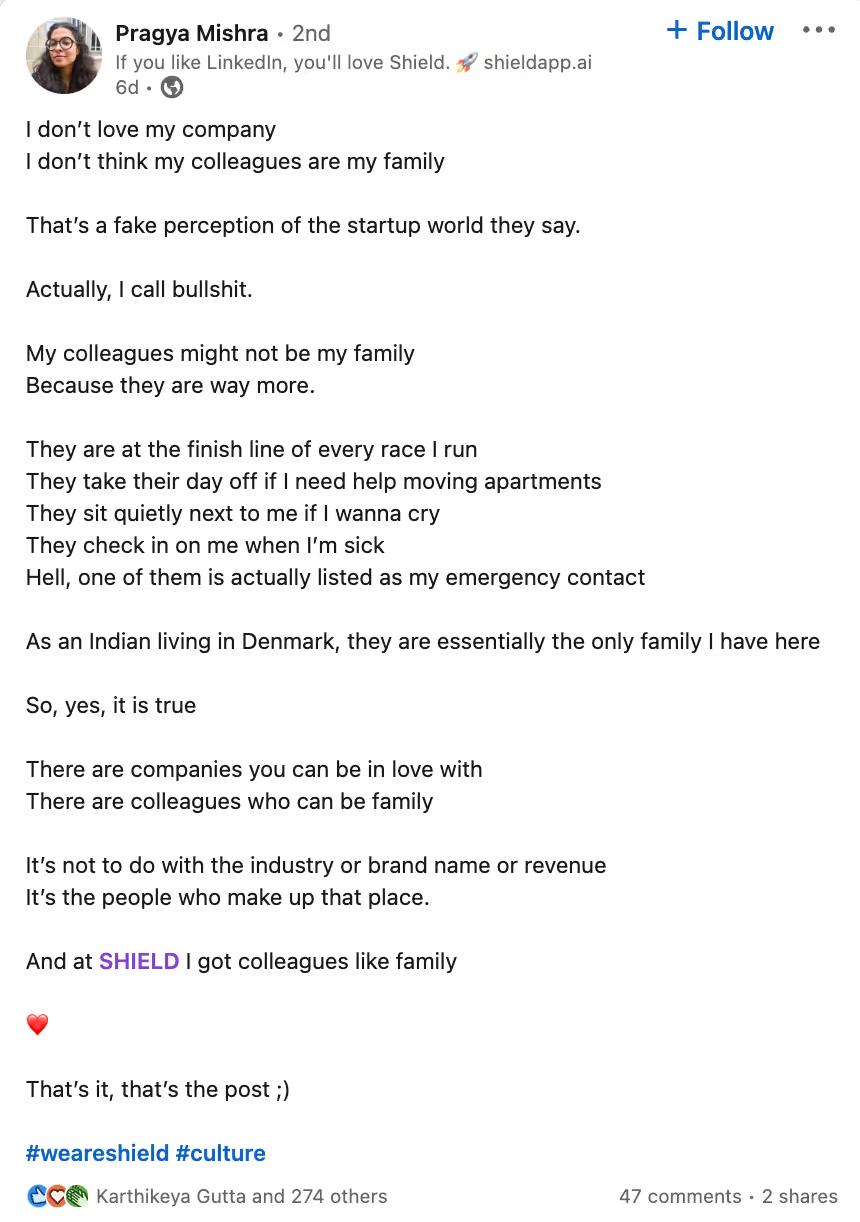
#2: Brand Ambassadors as Influencers
Many brands start working with social media influencers and eventually solidify the partnership by making them a part of the company’s brand ambassador program. Brand ambassadors offer exclusivity and a higher commitment to the brands they work with.
Example of a brand ambassador influencer: Emily
Emily is a beauty influencer and a brand ambassador for Peluka Salon. She shares posts with her personalized discount code every so often.

#3: Athletes as Influencers
Athletes and sports stars are amazing influencers for brands who sell products in the sports industry. One partnership with the right sportsperson has compounding effects because of their die-hard loyal fans.
Example of an athlete influencer: Haley Cavinder
Haley Cavinder is a basketball player and one of the Cavinder twins who were the first college students in NIL history to strike a brand deal. She often partners with brands like Champs Sports Women to promote their products on social media to her followers.
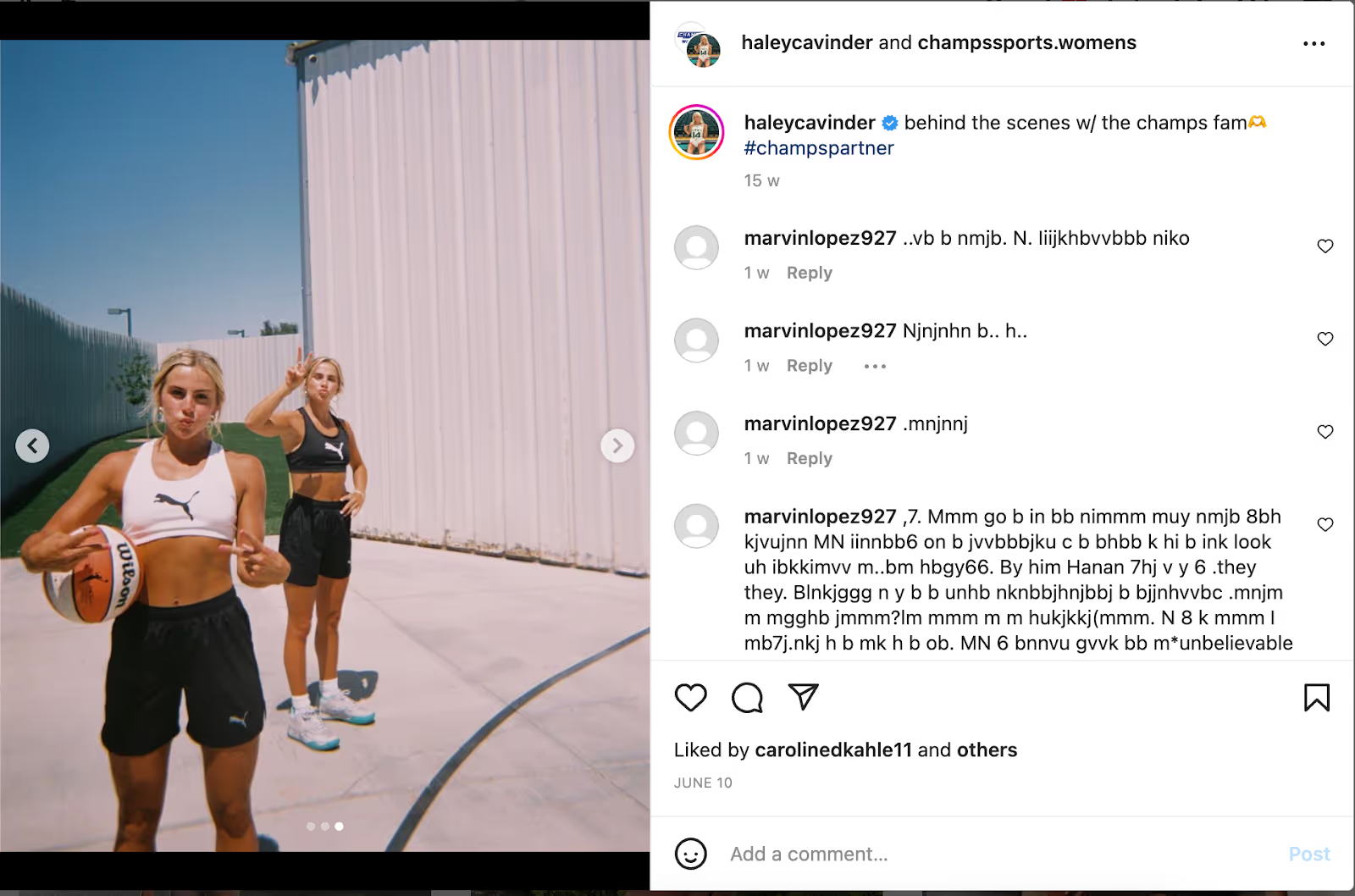
Read more: How to Connect With Sports Influencers to Promote Your Product
#4: Content Creators as Influencers
Content creators are the types of influencers who specialize in creating high-quality content. They don’t just produce social media posts that drive conversions, but aesthetic content worth repurposing over and over.
Example of a content creator influencer: Adriene Mishler
Adriene Mishler is a Yoga content creator with over 11.4M subscribers on YouTube. She does partner with brands like Adidas, but her primary mission is to create helpful Yoga-sessions for her community.
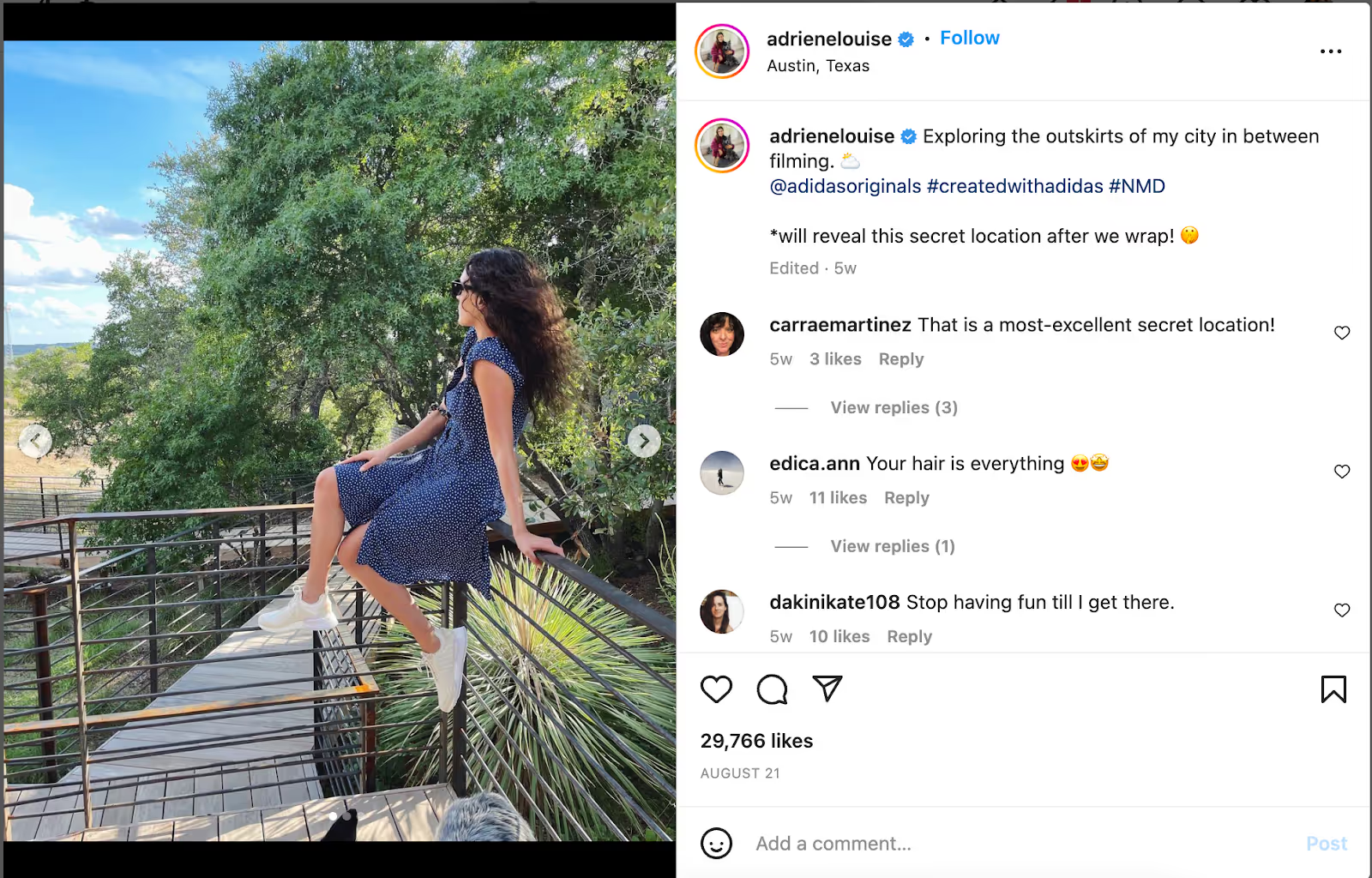
Read more: Influencers as Content Creators: A Checklist for Examining Content Creation Abilities
#5: Customers as Influencers
It’s hard to dismiss the power of user-generated content in influencer marketing. Friends, family, and review sites are still one of the most trusted sources of product recommendations for potential customers. The best part? You can repurpose user-generated content into valuable digital marketing assets. But be aware of any fake review or social media post about you.
Example of a customer influencer: Breanne Sich
Lululemon welcomes global and local ambassadors — whether they’re professional sportspeople or regular customers. Breanne Sich is a local ambassador who often posts about her favorite product lines from the store.

Read more: How To Get Quality User-Generated Content (UGC)
#6: Affiliate marketers as Influencers
Building an affiliate network with your influencers can be powerful in driving sales for your business. Affiliate marketers are often industry experts and send referrals within their community to purchase from your brand. Because they get a direct cut for every dollar they earn for your business, they have more skin in the game to bring you revenue.
Example of an affiliate influencer: Ashley Spivey
Ashley Spivey is an influencer running her book club, Spivey’s Book Club. She often shares her affiliate links for shoes, comforters, and any other products her followers ask recommendations for.
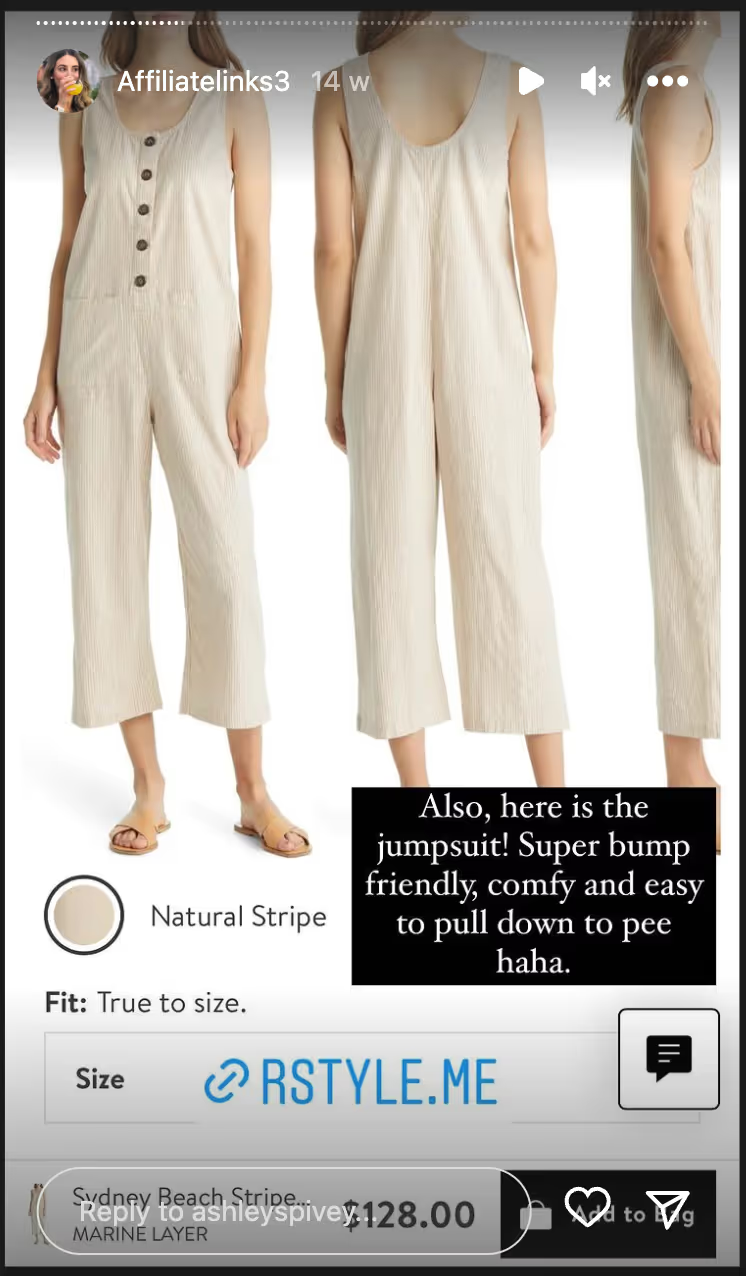
Learn more: How To Get Started With Influencer Affiliate Marketing
#7: Product collaborators as Influencers
Product collaborators go one step beyond influencers and launch a product with your brand. They partner with you on design, production, and promotion. Because of the heavy expenses in cost and reputation, it’s best to form this relationship with an influencer you trust and have been partnering with for a long time.
Example of a product collaborator influencer: Molly Mae
Molly Mae is a beauty influencer with a product line under her name at Beauty Works. She started as a brand ambassador for the company and graduated to become one of their product collaborators.
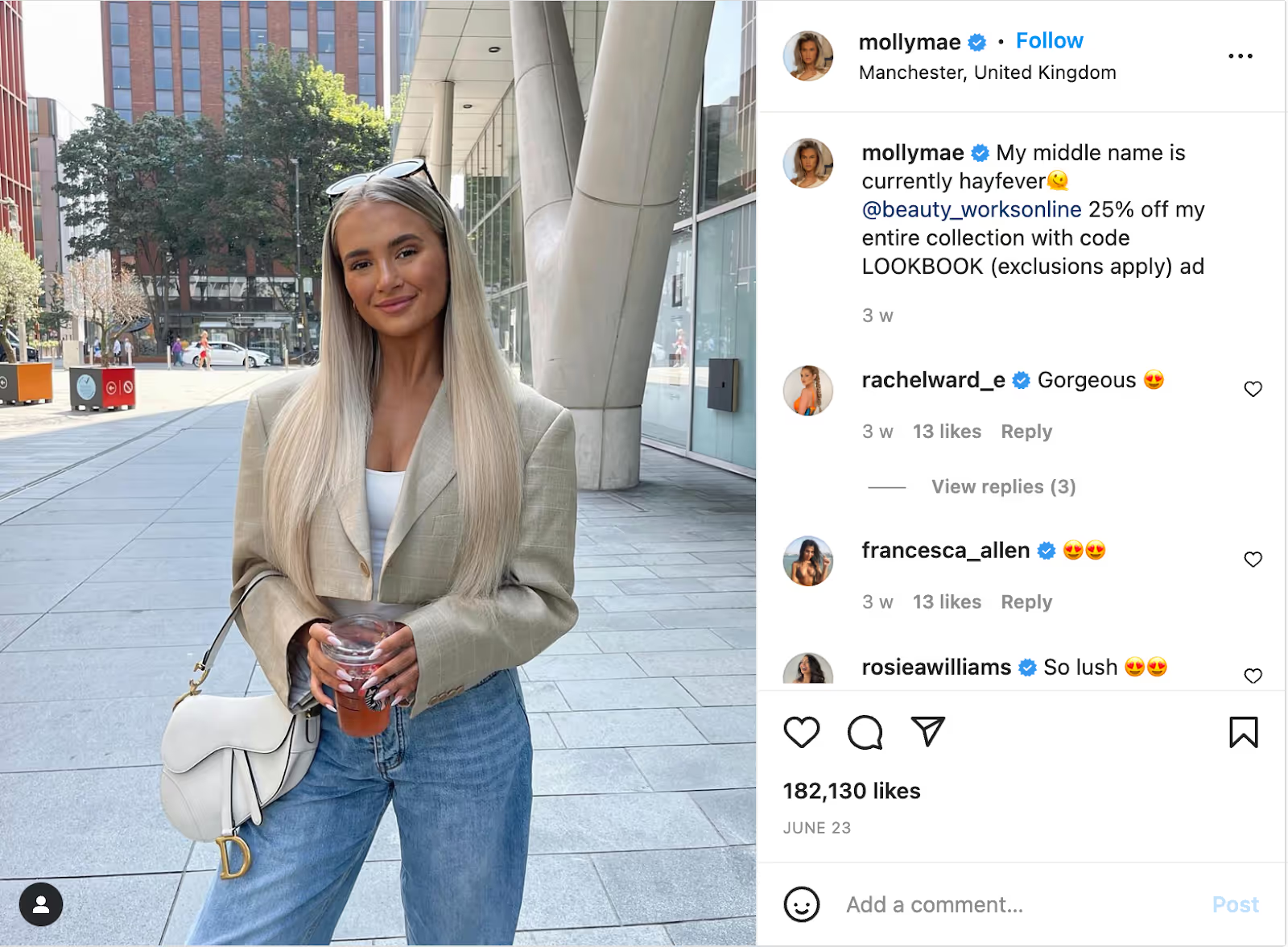
#8: Bloggers and Vloggers as Influencers
Bloggers and vloggers create informative and entertaining content for their niches. The difference between bloggers and influencers? Mainly the platform upon which they influence their audience. Plus, these types of influencers boost referral traffic through search engine optimization and enhance brand awareness. Bloggers and vloggers have a high-authority website or YouTube channels — but they still might have a significant following and social media presence.
Example of a vlogger influencer: Luke Damant
Luke Damant is a 22-year-old travel influencer documenting his journey around the globe. He partnered with Tourism Australia to make a reel about promoting tourism in the country.

#9: Thought leaders as Influencers
Thought leaders are CEOs, entrepreneurs, or people in leadership positions considered subject matter experts in their industry. These types of influencers have built a reliable reputation to be the go-to source of product recommendations, reviews, and insights in their niche.
Example of a thought leader influencer: Amanda Natividad
Amanda Natividad is a thought leader in the digital marketing community with over 114K followers on her Twitter account. She accepts sponsorships from brands for her newsletter, The Menu.
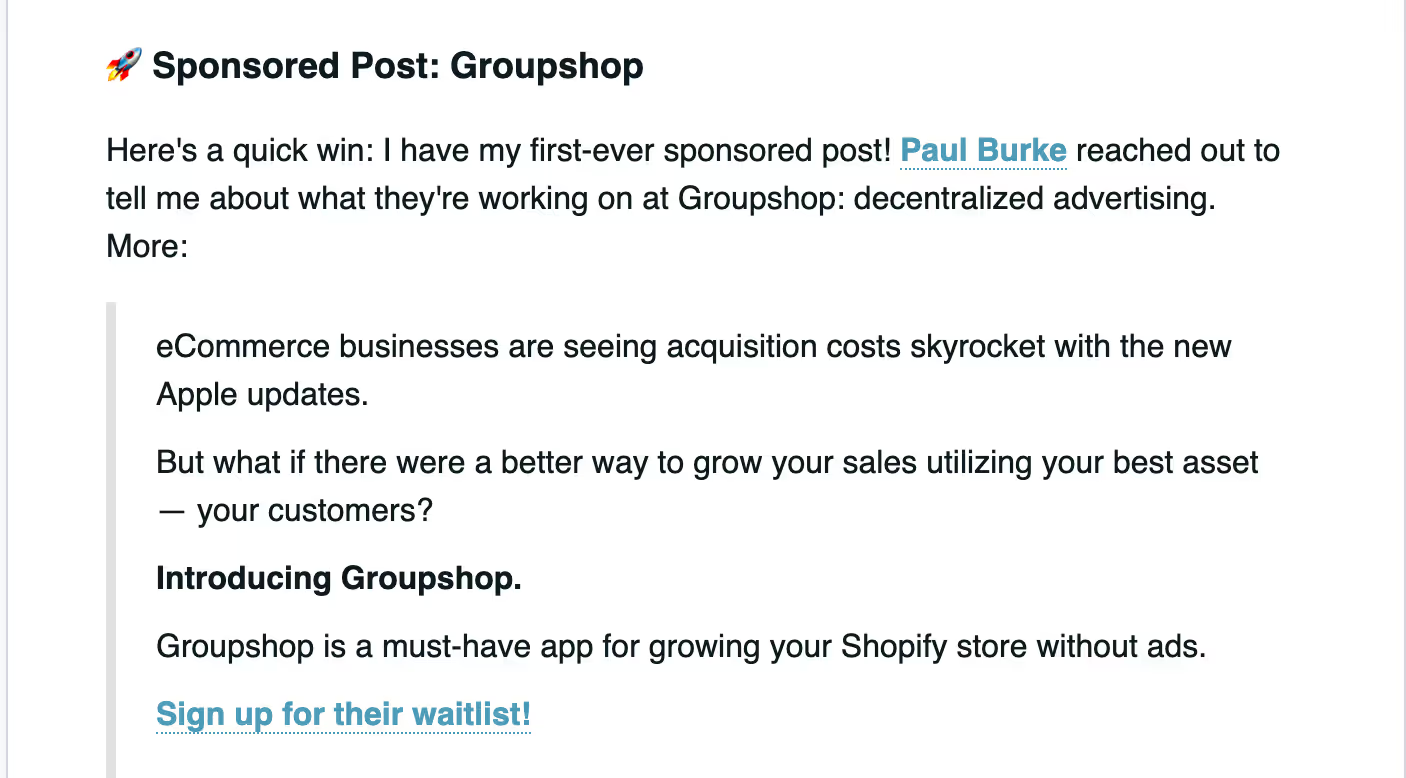
Which Type of Influencer Is Right for Your Brand: 5 Factors Should You Consider
There are many different types of influencers you can choose from. But how to determine which influencer is the right fit for your brand? Look at the following factors:
#1: Influencer Rates
The primary factor you should use for shortlisting is what types of influencers you can afford.
Micro-influencers are affordable for small businesses, while mid to large enterprises would be better off partnering with a variety of micro, mid-tier, and macro influencers.
If you’re ready to invest a heavy penny, mega-influencers are the way to go.
#2: Influencer Campaign Goals
Partner with different types of influencers for varying marketing goals. Brand ambassadors and affiliate marketers might be your perfect fit if you aim to associate with a famous face. Content creators are the right choice if your goal is to create high-quality digital marketing assets and video content.
#3: Audience
Your target audience should align with the types of influencers you’re partnering with. Macro-influencers are your best bet if you’re going for a diverse audience. Specialized thought leaders are a no-brainer if you want to serve a narrow segment. Match your target audience or buyer persona with the influencer’s follower demographic.
#4: Platform
Influencers are no longer limited to Instagram — or even types of social media. Depending on your influencer campaign goals and type of business, choose a platform-specific influencer. Gaming influencers are popular on Twitch but for B2B influencers, go on Twitter or LinkedIn.
#5: Fake Followers
Fake influencers are the parasite of your influencer marketing campaign. Micro-influencers looking for brand sponsorships might need more evaluation, but larger influencers whose business relies on their reputation are more trustworthy and have less chances of being fake influencers.
Learn more: Conducting a Fake Follower Audit on an Influencer’s Account
Choosing the Right Type of Influencer
Shoypes ortlisting and matching with the right influencer is taking a step in the right direction. There’s no doubt influencers can help build brand awareness. But if you choose the wrong influencer for your brand, you send precious marketing dollars down the drain.
Want a shortcut to separate the wheat from the chaff in your hunt of the right influencer? Hire a trusted influencer marketing agency like Kynship to guide you every step of the way — from finding the right social media platform to finding the right influencers. Chat with us to see how we can help.
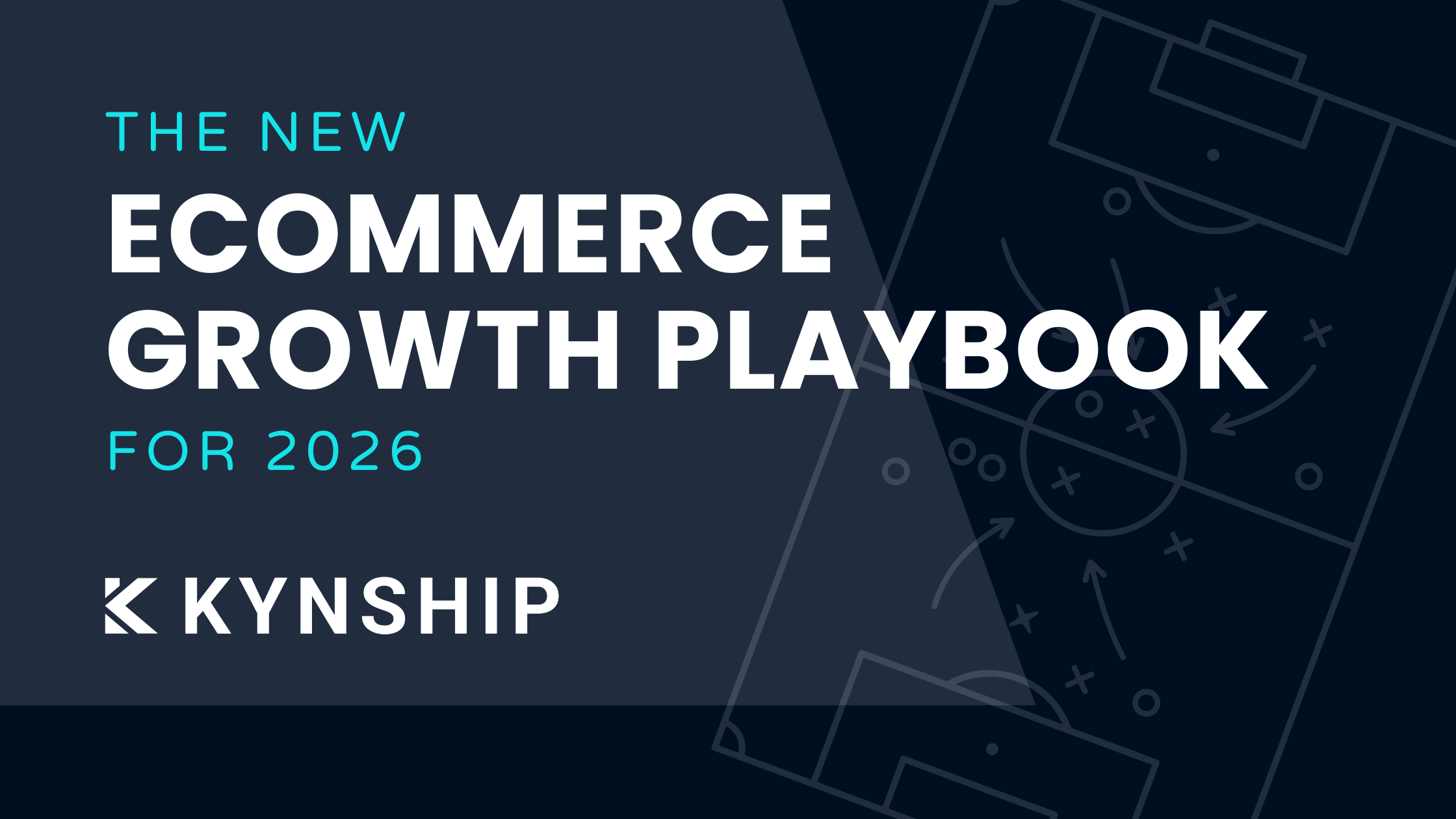
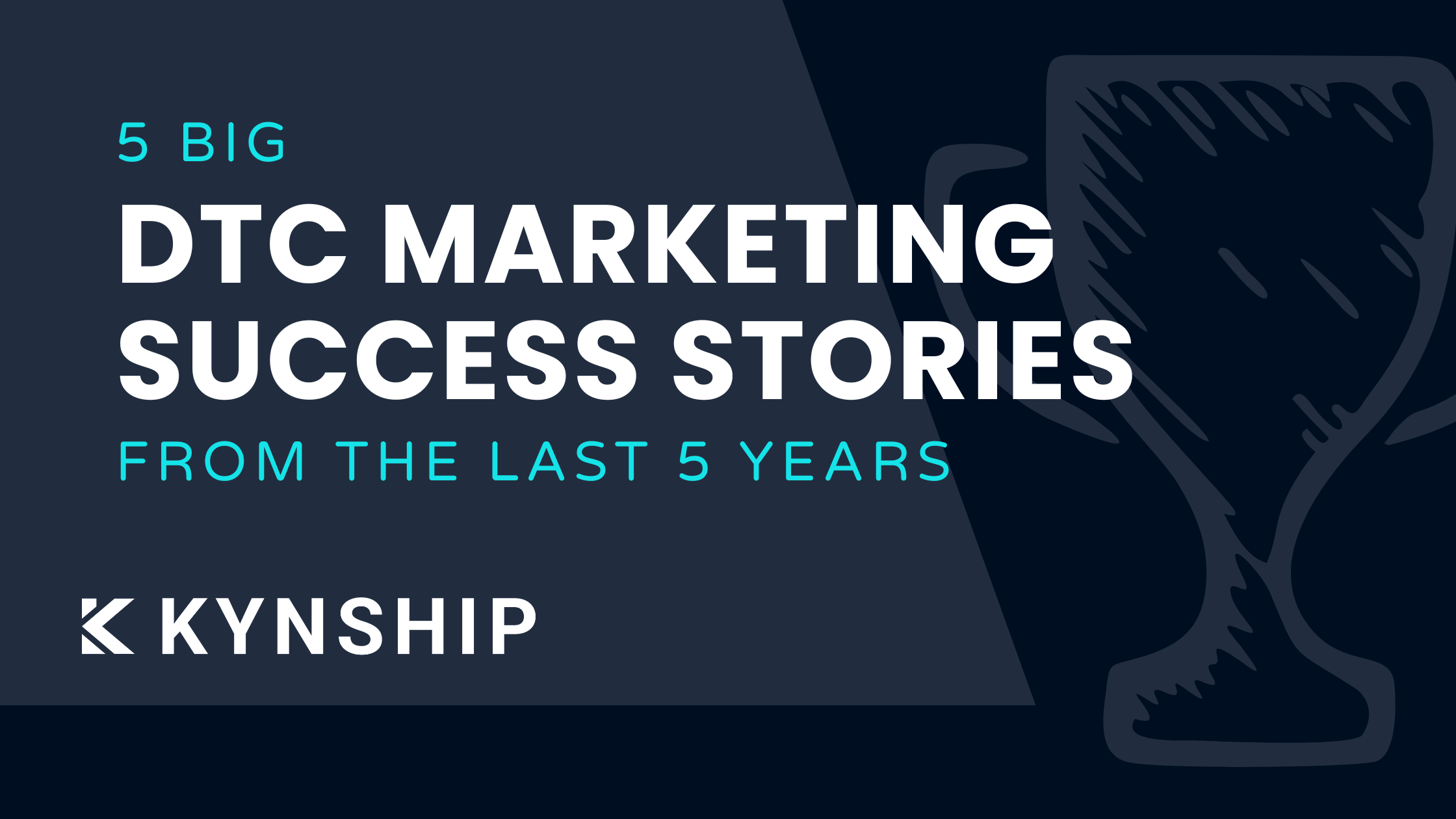
5 DTC Marketing Success Stories From The Last 5 Years
Five real DTC marketing success stories from the last five years, breaking down how brands scaled despite rising CAC, creative fatigue, and tougher competition, plus key lessons you can apply today.

The New Ecommerce Growth Playbook For 2026
These are the ecommerce growth marketing strategies we are using right now to successfully scale DTC brands from $2M to $50M.
Bi-weekly tips to reduce your CAC
Join thousands of DTC operators and subscribe to Cut the CAC for insights from the Bottom Line Podcast and Kynship's growth strategies.


.avif)
.avif)
.avif)



